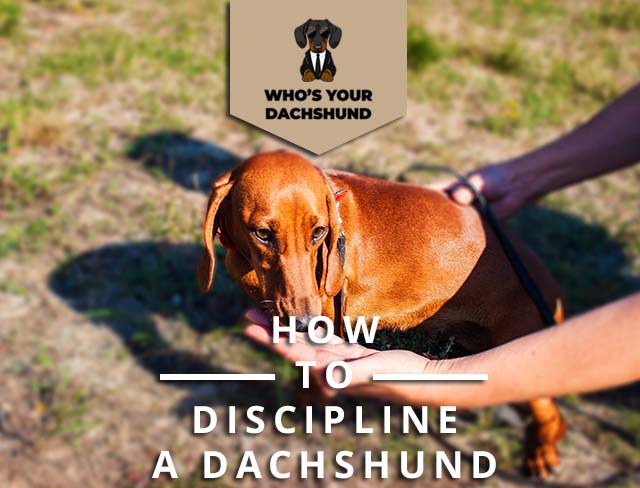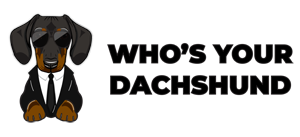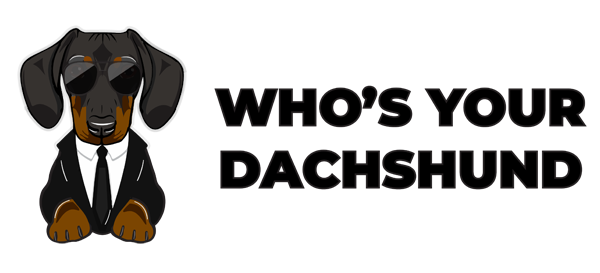
There are times when a Dachshund can be very difficult to control. This article will provide you with helpful tips on disciplining your Dachshund.
Dachshunds vary in their ability to train with patience and repetition; others are stubborn and difficult to train. Keeping a Dachshund active will help to prevent them from misbehaving, acting out, or taking out their aggression on your home. Consider getting your dog a playmate (if he is not already one), providing him with physical activity such as running, swimming, or fetching things. Playtime is another excellent way to spend bonding time with your dog. Dachshunds learn best through repetition and correction, so take the time to teach your dog correctly.
What Is Positive Reinforcement Training For Dachshunds?
“Positive Reinforcement Training” is a technique used to train dogs. It is based on the idea of positive feedback as opposed to negative reinforcement or punishment. Scientists and trainers have found this technique to be beneficial.
It is similar to the clicker training method because it uses positive rewards to motivate dogs to do what you want them to. It is a behavior modification technique that has been used on animals and with children with great success.
We reward our dachshunds when they do things we want them to do, like coming to us when we call their name, sitting on command, or lying down without being asked.
We use lots of praise and love. We want to let our dachshunds know that we are happy with them when they do the things we want. This training can be started at any age, as soon as you get your new puppy.
The trick is consistency. When your Dachshund is doing what you want, you should reward it.
What To Know About Durable, Washable, And Reversible Pet Beds
Durable, washable, and reversible pet beds have become increasingly popular for pet owners. They are designed to be comfortable and durable for pets, and easy to maintain. These beds can also shape like a donut to give your pet a cozy place to sleep or have a bolster to support and protect your pet’s head, back, and belly.
There are several features you’ll want to consider when shopping for a washable dog bed:
DURABILITY
Your first step should be getting a durable bed that you can wash without it falling apart. The right choice for durability will be an outer cover made of nylon or canvas with an inner cushion made from polyester fiberfill or foam. These materials are easy to wash and have the added benefit of being resistant to stains.
CUSHIONING
A dog bed with cushioning is going to be more comfortable for your dog than one without. Cushioning can be in the form of an inner pad or a nesting type fabric that supports your pet’s head, belly, and back. Padding can also come in the form of a bolster sewn into the product and cradle your pet’s body.
BENEFITS
The unique designs of some reversible beds offer the benefit of a bolster to help support your pet’s shoulders, neck, and back as they sleep. Others have a donut-shaped center that conforms to your dog as they lay.
SIZE
Ensure you get a dog bed that’s large enough for your pet. Most washable dog beds are made to be used by dogs up to 25 pounds, but many larger dogs still have room to stretch out their legs and bodies on these beds.
SIZE SHOULD BE A FACTOR IN YOUR PURCHASE DECISION
The right size will depend on the type of dog bed you choose. The best dog beds are meant to be used by large dogs or even small dogs that like to rest and sleep in larger spaces. In a resting position, your pet should be able to stretch out comfortably on the bed without feeling restless or confined.
DON’T FORGET COST
As with any pet product, you’ll also want to take price into account as well. Washable beds are generally more expensive than traditional dog beds, but they are reusable and can last for years, so you’ll save money in the long run.
Reversible Dog Beds As dog’s age, they often develop health problems that make it difficult to get comfortable and restful sleep. A dog bed with a removable bolster can give them the support they need to minimize pain and maximize relief. If you have an older age dog or one with developed back problems and hip dysplasia, then a removable bolster could be the perfect option.
My Dog Peed on My Couch in Front of Me: What Does It Mean?
A dog urinating in front of its owner is a way for the animal to mark its territory. Sometimes, these poor behaviors are associated with dominance, but they can also be caused by anxiety or fearfulness. First, take a look at the dog’s general behavior. If it seems relaxed and happy, it is unlikely that this act was intended to assert dominance. However, if your dog is acting aggressively or anxiously, this might be a sign that the dog feels dominant in some situations. Consider whether something in your household might cause your dog to feel threatened or defensive. These actions might be motivated by a new pet, a new baby, or even a home renovation. If you’re sure there’s nothing to worry about, then begin to take steps to correct this aggressive behavior.
The key to correcting your dog’s behavior is training. You need to train your dog not to urinate in the house:
- You have to catch the dog in the act.
- Make a loud noise such as clapping a book or yelling (do not use corrective growling). If it stops and looks at you, reward its good behavior with praise (try not to sound too happy about this training). If it does not quit, you should remove your dog from the area and take it outside its potty area.
- Ensure that your dog goes to the bathroom.
Ensure that they are comfortable with that potty area, not to bother them when they go there.
When your dog can control its potty break in the house, then you know that this was probably just a one-time problem rather than a sign of aggression or dominance.
Why Is Your Dog Acting Weird After Grooming?
Why is your dog acting weird after grooming? Does your dog act strangely after taking a bath? Your dog can act oddly or differently after grooming for various reasons. A few of the most common and some tips on how to deal with them:
Your dog is a dachshund, which means your dog will more than likely howl and fuss after being groomed. Some dachshunds will howl all the time because they are afraid they may miss their owner’s scent.
The best way to deal with this is to bathe your dog first, then give your Dachshund a chance to sniff you after the bath to reassure itself. Another reason is that your dog may feel like it has lost its territory or home because you’ve taken away its smell.
Another reason why your dog might act strange is that some dogs feel pain after grooming. That is mainly caused by ungroomed nails or rubbed skin due to allergies and dry skin.
Dogs that howl all the time also tend to have neck and spine problems. These dogs howl because they feel uncomfortable and stressed. They can’t tell if they are in pain or not, but some other part of their body is in pain.
These are all the most common reasons why a dog acts strangely after grooming. But if your dog is acting even stranger than usual after grooming, it’s best to take your dog to the vet for evaluation first. You can never be too sure.
You may not realize that your dog is acting weird after grooming, but your dog does. Your dog feels strange and uncomfortable after being groomed. I’d recommend scheduling an appointment with your dog’s vet if your Dachshund is howling all the time. Always remember that it’s better to be on the safe side than on the wrong one.
How To Stop Dachshund Behavior Problems
Finding out the essential characteristics of your child’s personality and thinking is the best way to prevent these issues. Once you understand your Dachshund’s signs of aggression, you will learn how to stop Dachshund’s behavior problems before they begin.
Dachshunds are smart as well as susceptible dogs. That does not mean that you shouldn’t train them. Dachshunds need a lot of daily mental stimulation to stop their behavior problems. But do not be surprised if you have a hard time training your Dachshund. It takes an exceptional person to handle these dogs’ strong-willed and stubborn nature.
You could do many things to stop your Dachshund’s behavior problems. This article discusses the following:
- Socialization
- Rules And Regulations Of Training A Dachshund
- House Training Methods
- How To Stop Barking And Biting
- How To Stop Digging, Chewing, And Jumping Up On People
- How To Stop Dachshund Aggression
- How To Stop Dachshund Separation Anxiety
- How To Stop Your Dachshund From Hurting Others
- How To Handle Dominant Dogs And Puppies
- Conclusion
Socialize Your Dachshund
There is a wide range of different types of dog breed comparisons on the internet. Some are factual, and others are not. The Dachshund is by all means one of the most and least adjustable breeds of dogs in terms of personality, behavior, and even size!
At first glance, the Dachshund looks like a very fierce dog. If you owned or intended to hold a Dachshund, this is likely familiar to you. However, a Dachshund that has been appropriately socialized is a beautiful dog to have around the house.
Dachshunds are practically considered lap dogs. They love to be in their owner’s arms. They also love to be carried around the house when their owners are busy doing things. Dachshunds especially love people. Having a Dachshund is very much like having a child in the house. They are very loving and very loyal. However, if you don’t socialize them when they are younger, they could become aggressive and sometimes even dangerous.
Do not let your Dachshund’s temperament get the best of them. It is impossible to have an untrainable dog, and there’s no such thing as an aggressive dog – except if you allow it to happen.
Socialize your Dachshund when they are young. Please take it to dog parks and play with other dogs. Let them meet as many people as possible to become more confident around others.
Dachshunds are known for becoming very protective of their owners. Still, if they do not have proper socialization, this can be a big problem in the future, especially if you plan on having your Dachshund around strangers or children.
Rules And Regulations Of Training A Dachshund
The best way to start training your Dachshund is by doing it as soon as they can learn. Though a Dachshund may look like a vicious and dangerous breed of dogs, they are very family-oriented in reality. They enjoy being around people, especially children. That is why they can be trained so easily.
To begin with, you must remain calm, relaxed, and collected when you train your Dachshund for the very first time. You must always be fair and never give in to your Dachshund’s wrong behavior.
You must avoid yelling and punishing your Dachshund when they do something wrong because they will become confused about why you are suddenly upset. However, punishing your dog in a calm and relaxed manner will indeed work wonders.
The best way to teach a Dachshund is to establish yourself as the master. You are the head of the pack, and they will not try to disobey you if you walk into the room with authority.
If you feel like your Dachshund is getting a little too out of control, it’s essential to establish yourself as the house’s head from day one. You can do this by picking up your dog and shortly scolding them.
Dachshunds are very gentle and friendly dogs. If you train them early, they will behave appropriately around others.
Housetraining A Dachshund
Though this may sound obvious, it is crucial to have your Dachshund house trained before interacting with young children. If you cannot have your dog house trained, or if the dog cannot hold their urine for long periods, you must keep them away from young children.
Because Dachshunds are so tiny and can easily be injured, they will likely try to bite if they feel uncomfortable or threatened. Having your Dachshund house trained is essential to prevent this from happening.
Dachshunds can be very stubborn when they want to hold their urine for long periods. Because they are small dogs, they do not just need to go outside to urinate; they need to do it often. That means that you must take your Dachshund out on a routine schedule.
You can set a routine schedule, such as once every three hours. This way, your Dachshund will not have to wait too long to go outside, and if they make a mistake in the house, it will be easier to clean up.
How To Stop Excessive Barking And Biting
A Dachshund’s bark is very similar to that of a puppy’s. It does not bark to express its feelings; they bark because it tries to get your attention.
Because they are always looking for your attention, a Dachshund will try to bite as well. It is essential to prove yourself as the pack leader’s leader from the start. You can do this by keeping your Dachshund in a crate for about three hours while you are away from the house.
When you are at home, you must be with your Dachshund as often as possible. This way, they will not feel as if they need to bite or bark when your attention is not on them.
How To Stop Digging, Chewing, And Jumping Up On People
Dachshunds are diggers by nature. However, you can discourage this behavior by keeping the dog in a crate for short periods after destroying something.
Dachshunds also love to chew on things. You can discourage this behavior by providing the dog with various toys and bones throughout the day. It is important not to let your Dachshund jump on people or furniture when they are younger. It will become a habit for them at an older age.
Older Dachshunds can sometimes become nervous when they are not home. One way of halting this behavior is by leaving music to play while you are away. They will feel less lonely and anxious because they will hear your music.
How To Stop Dachshund Aggression
Dachshunds are very intelligent, so that they can be trained. However, if your Dachshund is aggressive, it will be challenging to teach them.
Aggressive Dachshunds may need a trainer so they can learn to trust people again. Also, a trainer will give you advice on training your dog. It is essential to realize that you might not be able to train your Dachshund. If this is so, the dog may be kept in a crate.
How To Stop Dachshund Separation Anxiety
If your Dachshund suffers from separation anxiety, it will be essential to create a routine for them when you leave. That will help reduce its fears about being left alone.
If you are gone for long periods, consider leaving them with music. It has been proven that playing relaxing music can reduce anxiety in dogs and humans alike.
If your dog is enduring separation anxiety, consider consulting a veterinarian or behaviorist. They might be able to develop a new plan for helping you stop it altogether.
How To Stop Your Dachshund From Hurting Others
Some Dachshunds like to chase other animals, including people. You will need to train your Dachshund not to hurt anyone else. That is important because if your dog injures someone, you could be liable for the damages.
Even if your Dachshund hurts someone, you should not try to punish them or hurt any other animal. If you are worried about too much aggression, contact a trained dog trainer to help your pet.
How To Handle Dominant Dogs And Puppies
If you are an owner, you presumably know that sometimes your pet can be over-dominant. If so, don’t be afraid of it! It is possible to handle this situation.
To handle dominant dogs and puppies, you should understand their mindset first. Dominant dogs/puppies usually want to be the leader in their territory. They don’t want to obey even if they are required to do so because they think it’s beneath them.
However, it is possible to teach a dominant puppy/dog to obey you just like any other dog. You can achieve this by not being afraid when your pet becomes overly-dominant. Just be sure to show that you need not be treated that way.
Conclusion
There are many types of dog breed comparisons on the internet. However, only a few of them are factual and accurate. Dachshunds are a breed of dog you should become familiar with before owning one.
Dachshunds are not just cute dogs. They are fun, playful, and loving animals, perfect for homes with children. However, if they are not adequately trained and socialized, they can become aggressive, destructive, and even dangerous to approach.
You must train a Dachshund puppy as soon as possible to learn to behave accordingly around other people and animals.

